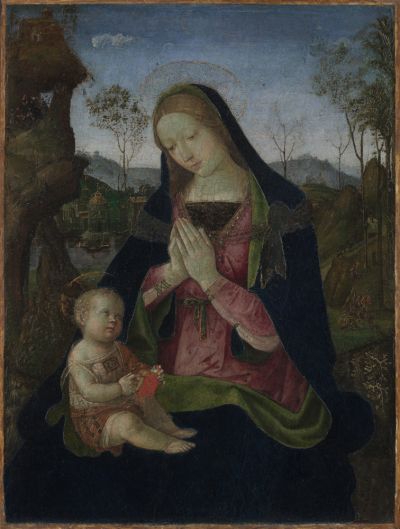Pietro Vannucci, meglio noto come il “Perugino”, fu un pittore italiano del XV secolo, che i contemporanei considerarono come il più importante tra i protagonisti del rinnovamento dell’arte italiana nel culmine del Rinascimento. Titolare di due attivissime botteghe a Firenze e Perugia, fu anche il maestro di Raffaello. Assieme a loro, Bernardino di Betto Betti, soprannominato il “Pinturicchio”, si impose come un altro dei “grandi” della scuola umbra del secondo Quattrocento. Grazie all’opera di questi artisti lo stile umbro si irradiò nei più importanti centri della penisola, conquistandoli.
Visitors to Umbria will delight in her many wonderful cities such as Gubbio, Orvieto and Assisi, all noted for their historical architecture, art, local horticultural products, and wine. Located in the very heart of Italy, Umbria is characterized by its verdant hills, mountains and valleys punctuated with Franciscan basilicas and hilltop towns. The region incorporates the central Apennines resulting in one of the most picturesque and dramatic landscapes in Italy. No visit to Umbria would be complete, however, without a stop in the provincial capital of Perugia. The city is located on a high hill overlooking the confluence of two valleys: the Umbrian valley, stretching from Perugia to Spoleto, and the Tiber Valley, west of the first one, from Città di Castello to the border with Lazio.
Perugia today is a well-known cultural and artistic center. The city hosts multiple annual festivals and events, such as the Eurochocolate Festival (October) and the Umbria Jazz Festival (July). The city hinges around a single street, the Corso Vannucci, named after the city’s most celebrated artist, Pietro Vannucci (1450–1523), better known as Perugino. Lined with bustling pavement cafés, this is one of Italy’s greatest people-watching streets, packed from dawn through the early hours with a parade of tourists, students and local residents. Perugia prides itself in having one of Italy’s great universities (founded in 1308) and a superb museum, the Galleria Nazionale dell’Umbria, home to an important collection of Renaissance painting and sculpture. Most visitors will note the preponderance of spectacular Renaissance buildings in the city center—the Cathedral of San Lorenzo, the Palazzo dei Priori (1303), once the center of local government and today home to the city’s museum, and the Fontana Maggiore. This exquisite fountain is located between the cathedral and the Palazzo dei Priori and is the pride of all Perugini. It was made between 1277 and 1278 by sculptors Nicola Pisano and Giovanni Pisano.
For today’s visitor, a stroll through the city center clearly reveals another era, the Renaissance, a moment in history that saw Perugia’s emergence as the birthplace of an important school of painting and the home to great artists including Fiorenzo di Lorenzo, Perugino, Pinturicchio, Bartolommeo Caporali, and Raphael. Perugia’s two greatest sons were the painters Perugino and Pinturicchio, both of whom flourished in the city’s creative milieu. Typical of Renaissance artists, they often left their hometown in search of commissions.
Pietro Vannucci, who was nicknamed “il Perugino” after his hometown, became one of the foremost masters of the early Renaissance. He produced a considerable body of work and influenced many of his contemporaries. By the age of nine, Perugino was apprenticed to a master in Perugia. He was one of the earliest Italian practitioners of oil painting in place of tempera. He distinguished himself quickly and was offered commissions in various cities such as Arezzo and Florence. In 1480, he was called to Rome by Pope Sixtus IV to paint frescos for the Sistine Chapel walls. In 1499, he was back in Perugia to paint frescos in the audience hall of the Guild of the Cambio (bankers). Perugino was honored by the city in 1501 which made him one of the priori (magistrates) of Perugia. A little later he was summoned back to Rome by Pope Julius II to paint a commission at the Vatican. Pope Julius, however, soon preferred a younger competitor, Raphael, who ironically had been trained by Perugino.
A contemporary of Perugino was the painter Bernardino di Betto (1454-1513), who was nicknamed Pinturicchio (“little painter”) because of his small stature, a name which he used to sign some of his works and by which he is known to modern art historians. By 1481, Pinturicchio was closely associated with Perugino, whose influence on him was major. Both artists collaborated on a number of projects. In the 1480s, Pinturicchio worked in Rome on frescos for the Bulfalini Chapel in Santa Maria in Aracoeli and in Santa Maria del Popolo. An example of Pinturicchio’s work from the 1490s is a “Madonna and Child” panel now preserved in the Cleveland Museum of Art. The original patron of this work is unknown. However, given the painting’s small scale, it was unlikely made for a church. It was probably produced as a devotional picture for a home or private chapel. It demonstrates that smaller commissions like this were often part of the livelihood of Renaissance painters.
Pinturicchio’s most important work of this period was the decoration of a suite of six rooms in the Vatican known as the Borgia Apartments for Pope Alexander VI between 1492 and 1494. Here, Pinturicchio relies on brilliant, often jarring colors, gilding and ancient Roman ornamental motifs. The artist’s last major works were the 10 scenes from the life of Pope Pius II painted between 1503 and 1508 in fresco in the Piccolomini Library in Siena. In these, space, color and detail are handled with the great proficiency of a true Renaissance master.
Florence for the modern visitor is emblematic of the early Renaissance, and not without justification. However, Perugia’s role runs deep and should also be considered. Her contributions to Renaissance art, her home to important painters and an Umbrian school of painting form a significant legacy. Perugia should be part of any Italian itinerary for Renaissance art.



